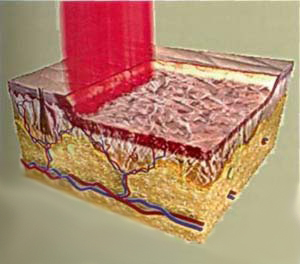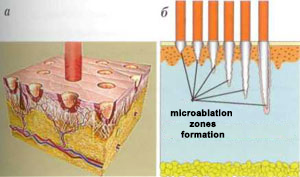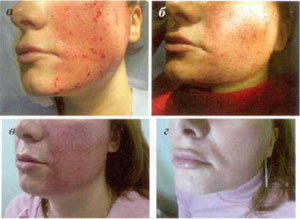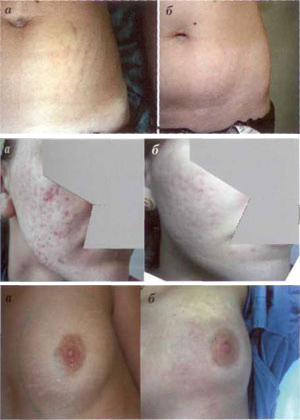Today in the arsenal of modern dermatocosmetology there are a wide range of methods for the repair of various aesthetic defects of the skin - chemical peeling, mechanical dermabrasion, laser resurfacing, microdermabrasion, contour plastics. New trends and technologies in the beauty industry are constantly evolving and improving.
This trend is particularly evident in hardware techniques for laser medicine. The use of lasers, first in dermatology and then in cosmetology, has an influential period. One of the newcomers has appeared - laser treatment - selective photothermolysis - for more than 25 years. The pioneers of this field, the Americans R. R. Anderson and J. А. Parrish predetermined the fate of fractional lasers in medicine, making them irreplaceable in such aesthetic treatments. Skin defects such as capillary hemangiomas. Port wine stains, hypertrichosis, tattoos, rosacea, pigmentation disorders, painting, wrinkles, etc. b.
Modern skin care techniques
We live in a time when more people are getting older than before. Given that many of them lead active lives, one of the most important problems of aesthetic medicine is the fight against skin aging.
Plastic surgery removes excess skin and rejuvenates the shape of the face. But at the same time, the skin changes over time (age-related aging) or due to external factors (painting). Most patients look younger without the more important surgery they want.
What method should be used on the skin in this case and what should be done for its real rejuvenation?
All the methods used to improve the appearance of the skin are united by one principle - they have a traumatic effect on the skin, which causes fibrosis, and further leads to its tension and compression.
Currently, dermatocosmetology uses three types of skin repair effects, including:
- chemical stimulation - acids and chemical coatings (trichloroacetic, glycolic, etc. );
- mechanical stimulation - mechanical dermabrasion using needles, microdermabrasion, mesotherapy, fillers, subsection;
- Thermal stimulation - laser ablation, thermolysis using lasers and broadband light sources, radio frequency augmentation, fractional methods.
Chemical stimulation
Historically, the first method of skin rejuvenation was oxygen (peeling). The principle of peeling is the partial (almost top peeling) or almost complete (like medium and deep peeling) destruction of the epidermis, causing damage to fibroblasts and dermis structures. This damage activates the inflammatory reaction (the stronger the damage, the greater the amount of destruction), which leads to the production of additional collagen in the skin.
However, in order to achieve the desired result, peeling must sacrifice the epidermis. Experiments with burns have misled many and proved that the epidermis is a regenerating organ and can quickly repair the damaged area. area. Because of this, peeling became increasingly aggressive to the epidermis (e. g. , deep phenolic peeling), and until the accumulated problems eventually emerged, experts realized the brutality of this. The method that causes the skin to become thinner.
Proponents of skin cleansing have denied the problems. Their significance lies in the fact that due to the absence of papillary dermis and poor nutrition, the epidermis becomes thinner and the number of cells in the relatively vertical layer is significantly reduced before peeling. Decreased barrier function of the stratum corneum leads to decreased hydration of the skin. (Therefore, after deep peeling, almost all patients suffer from severe dryness of the skin for a long time. ) At the same time, the implementation of light peels (using trichloroacetic and fruit acids) did not live up to expectations of effective skin strengthening.
Mechanical stimulation
One of the methods of mechanical stimulation of involutionary changes in the skin is dermabrasion with the use of rotating tools (with a speed of v; the rotation of the cutters is 100, 000 rpm); special attention should be paid. Currently Schumann-Schreus modern tools are used (Germany)
This method can only be used in a surgical hospital, as the procedure requires anesthesia, postoperative treatment of the wound surface, a special toilet for the eyes and mouth, and special equipment. feeding patients (postoperative swelling that occurs 2-3 days after the procedure makes it difficult to open the eyes and mouth).
This method is very effective, but, unfortunately, in combination with mechanical dermabrasion, the risk of such diseases is high:
- persistent postoperative hyperemia;
- formation of depigmentation zones due to the absence of melanocytes when the cutter enters through the basement membrane;
- wound surface infection; Try
- (if the cutter is too deep into the skin)
All of the above have led to limited use of this method in clinical practice.
Thermal stimulation
Ablative correction
Since the late 1980s, lasers have been used to rejuvenate the skin by ablation. Careful, traumatic removal of the upper layer of the skin with the help of a carbon dioxide laser, including enhances the synthesis of its own collagen, the amount of which increases several times after the procedure. Then it was gradually reorganized.
The most effective is the use of a CO2 laser, which has a profound thermal effect on all layers of the dermis, with a gravitational effect on the skin. This method did not contradict other methods of rejuvenation called “laser dermabrasion” or “laser” and was effective at the time (Figure 1).

image. 1. Traditional laser skin rejuvenation scheme (laser dermabrasion)
However, the CO2 laser poses many more problems. In addition, subsequent studies have shown that such a profound effect on the dermis causes the formation of muscle tissue rather than new, normal synthesis. targeted collagen [5]. As a result of the developed fibrosis, the skin appears to turn naturally pale. After treatment, the synthesized collagen, like the collagen formed at the site of the scar, is revived after a few years. As a result, small wrinkles begin to form on the skin of the epidermis, which is caused by atrophy of the papillary layer of the thinner skin. Due to the smooth functioning of the stratum corneum, the skin's moisture level decreases and it appears atrophic.
Erbium-aluminum-yttrium garnet-erbium lasers appeared a little later. The advantages of erbium lasers such as thermal depth (erbium lasers to a depth of 30 microns, CO2 lasers - up to 150 microns) and (as a result) low risk of burns and carbonization of the soil, as well as relative cheapness (compared to carbon dioxide lasers) many experts around the worlddrew attention.
However, experience has been gained with these two types of installations, and experts believe that CO2 lasers are effective [6]. Despite the negative effects of laser dermabrasion of carbon dioxide described above, this method remains indispensable for the repair of acne scars. In addition, it can be considered as an alternative to surgical strengthening of the skin - in all methods of its restoration, the effect of a CO2 laser can only lead to a clear vision. Compression of collagen with a visible clinical lifting effect.
The problem with all the methods described above is that they are often "sacrificed", that is, they cause serious damage to the epidermis. To rejuvenate your skin and make it look really young, you need natural flawless epidermis papillae, good hydration, normal skin tone and elasticity. The epidermis is a very complex specialized organ, up to 200 microns thick, which is our only protection from the effects of environmental factors. Therefore, no matter what we do to rejuvenate the skin, its normal architecture should never be compromised.
This concept has led to the emergence of non-ablative skin repair technology.
Non-ablative correction
The most common devices for non-ablative skin repair are neodymium (Nd-YAG) and diode lasers, as well as broadband light sources (IPL). The principle of their action - selective photothermolysis - heating and demolition of structures, contains sufficient amounts of melanin or oxyhemoglobin. In the skin, these are the accumulation of melanocytes (lentigo, melasma) and microvessels (telangiectasia), respectively. The irradiated wavelengths used in non-ablative lasers correspond to the maximum absorption spectra of oxyhemoglobin or melanin. The procedure with ablative laser and ILP treatment is much safer, the recovery period is minimal, but such treatment eliminates only pigmentation and vascular cosmetic defects. In this case, a certain thickening of the skin is observed, but the effect is short-lived.
Fractional methods of skin regeneration
The constant search for new, highly effective and at the same time safe ways to rejuvenate the skin has led to the emergence of a revolutionary technology - fractional delivery of laser radiation. The proposed skin rejuvenation method is specifically designed to overcome some of the above challenges. Unlike “conventional” ablative and ablative laser methods, which are designed to provide uniform thermal damage to the skin at a certain depth, fractional methods allow. To achieve the selected microscopic thermal damage, in the form of numerous modified columns and leaving unsuitable areas around the micro-wounds. Currently, the industry produces two types of fractional lasers: non-ablative and ablative.
The first uses an optical fiber in an erbium ball, which emits radiation at a wavelength of 1550 nm. Fractional lasers form thousands and tens of thousands of microdermabrasions in the skin in the form of colonies - microthermal treatment zones (MLZ) - 70-150mk in diameter to 1359mkm deep
As a result, about 15-35 skins are photocoagulated in the cleaned area. Laser chromophore - water, coagulation occurs mainly in the lower layers of the epidermis and dermis. The stratum corneum retains a relatively small amount of fluid due to its composition, and this significantly reduces the risk of infection. Due to the low rate of epidermal regeneration and the short migration distance of keratinocytes. The healing period is accompanied by moderate swelling and redness that occurs on day 5-7, followed by desquamation. The patient does not actually lose social activity.This technology - fractional photothermolysis (FF) - is a highly effective method of non-ablative fractional skin repair. A course of treatment is prescribed to achieve the desired effect. It is recommended depending on the clinical situation. Perform 3-6 procedures every 4-6 weeks. As with other non-ablative skin rejuvenation methods, the final result can be seen only 4-8 months after the procedure (cumulative effect).

In cases where the skin is more aggressive - fractional ablation (FA or fractional deep dermal ablation - FDDA) is used to repair scars, remove deep wrinkles and remove excess skin.
The fractional ablation method combines the advantages of the CO2 laser and the fractional principle of laser radiation. Unlike the traditional CO2 laser, which removes all layers of the skin surface by layer, FA forms a single microblastic multimode (MAL) with a diameter of 300 μm and a depth of 350–1800 μm (Figure 2).
Thus, in this procedure, the laser beams entering the deeper layers of the skin damage the top layer of the epidermis. In terms of efficiency, the rejuvenation of the abrasive fractional laser can be compared to plastic surgery, and thus the depth of the laser beam.
image. 2. The principle of operation of the ablative fraction laser: the formation of microablative zones - MAZ (a); Dependence of the depth of MAZ formation on the power of laser radiation (b)
Like FF, 15 to 35% of the skin in the cleared area (in some cases up to 70%). Recovery after the FA procedure is faster than layer ablation. Due to this significant fact, part of the epidermis and stratum corneum is not preserved. After the procedure, the skin bleeds for a while, but soon stops (Figure 3, a).
image. 3. Step-by-step recovery of the skin after a partial ablation procedure: immediate vision after treatment (a); every other day (b); After 5 days (c); 14 days (d)
after one procedure
Many microbes form in the dermis, creating a complex cascade of changes that lead to the production of new collagen. Once the bleeding has stopped, the serous fluid left on the skin should be removed. Within 48 hours after the procedure, its release is observed before the onset of complete epithelialization of microabulatory areas. During this period, the patient uses special external means to heal wounds. Peeling usually begins in 3-4 days and the tumor increases (Fig. 3 c). On day 7, these symptoms gradually subside and have a negative effect that can only be observed with erythema (Fig. 3d). The duration of the erythema depends on the parameters of the laser effect. Rooting features of steels. According to the author, the erythema does not last more than 3 months.
After the FA procedure, the patient's loss of social activity lasts from 5 to 10 days.
Skin should be carefully cared for to prevent wrinkles and post-inflammatory pigmentation. Decorative cosmetics can be used from 4-5 days. To achieve a good result - it is necessary to provide a high level of protection (SPF at least 50) for at least 3 months after the day-to-day protective cosmetic procedure. The risk of post-inflammatory pigmentation occurs in 20% of patients and is higher in patients with skin types IV-V phototypes. This hyperpigmentation is natural and can last from 1 week to 3 months, depending on the depth of treatment and the area of the area being treated. To prevent it, external agents based on hydroquinone (4%) and tretinoin (0. 1%) are prescribed 1-2 weeks before the procedure and 2 weeks after the procedure. The main effects on the facial skin after the FA procedure are: flattening of the face and reduction of excess skin, wrinkled skin, as well as skin affected by acne scars, reduction of dyshromia, porosity.
This method has been tested by the author and his colleagues to eliminate stretch marks on the skin. Clinical studies have shown that this method is highly effective in eliminating almost all types of pre-adult symptoms in the post-adolescent period. It has been noted that the healing processes on the skin of the body are different from those on the face.
Skin Correction Mechanism Using Fractional Lasers
Let's look at the mechanisms of skin repair using fractional lasers.
Aseptic inflammation occurs in the area of micro-wounds formed after contact with the laser. The more aggressive the laser effect, the more pronounced the inflammatory response, which is actually the infiltration of damaged tissue by fibroblasts and post-traumatic stress-enhancing factors. The oncoming reaction is automatically accompanied by an explosion of cellular activity, which inevitably causes the fibroblasts to begin producing collagen and elastin. The skin regeneration process consists of three classic stages:
- Phase I - change (inflammation of the tissue). Starts immediately after damage;
- Phase II - proliferation (tissue formation). It begins 3-5 days after injury and lasts about 8 weeks;
- Phase III - tissue regeneration. Lasts from 8 weeks to 12 months.
It should be noted that the three stages of skin regeneration are observed both after fractional photothermolysis and fractional ablation. However, in the first case, the damaging effect of the laser is moderately aggressive, resulting in a cascade of inflammation that is never too wild to change.
After exposure to a particle ablation laser, a completely different phenomenon is observed. The trauma caused by this laser tears the blood vessels and turns them into circulating tissue along with the blood cells. The mechanism of complete blood vessel recovery - phase changes begin - aseptic inflammation occurs. Platelets from damaged blood vessels play an important role in activating blood clotting and releasing chemotoxic factors. In turn, platelets, leukocytes and fibroblasts are involved. Leukocytes, especially neutrophils, take part in the cleansing of the tissue, removing parts of the necrotic tissue that are partially destroyed by the phagocyte. appear on the surface of the skin in the form of microscopic fragments of microepidermal necrotic fragments (MENO) consisting of substrates of epidermal and dermal tissues and melanin.
The proliferative phase begins in about 5 days. During this period, neutrophils are replaced by monocytes. Monocytes, keratinocytes and fibroblasts affect growth factors and at the same time have a negative effect on them. Keratinocytes stimulate the growth of the epidermis and produce the growth factors needed by fibroblasts to stimulate collagen production. During this phase, new blood vessels form and the extracellular matrix is intensively formed.
The recovery phase after a partial laser treatment lasts several months.
On the 5th day from the day of injury, the fibroekt matrix sits along the axis, on which fibroblasts are lined up and collagen is built. The growth factor in the structure of this matrix varies (TGF-a is a chemotoxic agent for strong fibroblasts) as well as growth factors. The main form of collagen in the early stages of wound healing is type III collagen (this type of collagen is located in the upper layer of the dermis, below the basal layer of the epidermis). The longer the alteration phase, the more type III collagen is produced, but in any case, its amount increases from 5 to 7 days after damage. Collagen type III is gradually replaced by collagen after about a year. Type I, which strengthens the strength of the skin. Gradually, blood circulation returns to normal, and the skin becomes smooth and natural.
Comparative analysis of laser skin repair methods
Summarizing the above, here is a diagram showing the relationship between the effectiveness and safety of laser skin repair techniques.
Advantages of fractional track rejuvenation methods. The advantages of fractional methods used in clinical practice include:
- Minimal skin damage. Postoperative histological examination showed an increase in papillary papillae, which characterized the changes in the skin as fruitful regeneration;
- its effective rejuvenation: thickens the skin, which significantly (more than 400% (! )) increases the production of collagen and elastin;
- short recovery time: on average 3 days and 7-14 days after PA;
- minimal risk of hyperpigmentation;
- Ability to perform the procedure in patients with thin skin;
- has a healing effect on any part of the body;
- Possibility of using light forms of anesthesia: with fractional photothermolysis, only local anesthesia is used, a combination of conduction and infiltration anesthesia is required for fractional ablation; Loss of telangiectasia (cannot be restored due to rupture of blood vessels).
Key Indicators of Fractional Treatment

Instructions for fractional photothermolysis:
- In the early stages of aging, the density of the skin increases. The FF procedure is relatively easy and can be performed without fear. Therapeutic effects can be applied to the neck, décolleté, arms, abdomen, buttocks, mammary glands;
- skin photography;
- hyperpigmentation, melasma;
- hypertrophic scars;
- stretch marks.
Fractional Ablation Indicators:
- Wrinkles of varying severity - from fine lines to hard (in the form of furrows);
- age-related loss of skin elasticity and firmness;
- Excess skin on eyelids, neck, face (as an alternative to plastic surgery);
- uneven texture;
- skin photography;
- acne scars;
- cicatricial deformity of the skin after surgery after injury;
- hyperpigmentation: melasma, lentiginosis, red pigmentation, etc. b.
- vascular dyschromia;
- skin stretch marks;
- actinic keratosis.
In conclusion, a few words about the prospects for the use of laser technology in aesthetic medicine. We should thank the manufacturers for paying more attention to the safety of medical procedures using lasers. Technology is constantly evolving However, the safety of the method is often stumbled to increase its efficiency. Or vice versa. A compromise has been reached on a new principle for the delivery of laser radiation to the tissue. It should be noted that the types of lasers remain the same: erbium, carbon dioxide, neodymium. This means:
- First, laser skin repair has been found to be the most effective today;
- secondly, there is a wide range of coverage of aesthetic and dermatological problems solved by these methods - from skin rejuvenation to the treatment of congenital and acquired skin pathologies;
- Third, with the advent of fractional technology, the safety and efficacy of treatment have become predictable.














































































